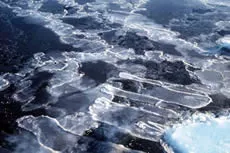Cryosphere glossary
radiative forcing
a measure of the additional absorption of solar radiation from light absorbing particles (LAP) such as dust or soot. Units of measure are Watts per square meter (W/m2) and values can range from 0 to 500 W/m2. The maximum value depends on incoming solar radiation (elevation, direct sun vs shaded) and the amount of dust or soot. A value of 0 means no additional radiation is being absorbed. A value of 500 means nearly all of the solar energy is absorbed (depends on latitude, elevation, clouds). Radiative forcing is calculated by the difference between the net (downward minus upward) radiative fluxes (irradiance) with and without LAP.
radiosonde
instrument intended to be carried by a balloon up through the atmosphere, equipped with sensors to measure one or several meteorological variables (pressure, temperature, humidity, etc.), and provided with a radio transmitter for sending this information to the observing station.
radius-dependent metamorphism
snow metamorphism that occurs when there are large differences in convex and concave portions of a crystal.
rafted ice
deformed sea ice in which one piece has overridden another; also called telescoped ice.
rafting
a process by which currents or winds push around thin ice so they slide over each other; also called finger rafting.
Image

Nilas showing finger rafting.
Antarctic Sea-Ice Processes and Climate (ASPeCt)
ram
a horizontal underwater projection of ice from an ice front, ice wall, iceberg or floe.
randkluft
a fissure that separates a moving glacier from its headwall rock; like a bergschrund.
rawinsonde
radiosonde which is tracked by radar or radio-theodolite to measure the wind aloft.
reconstituted glacier
a glacier that is reconstructed or reconstituted out of other glacier material; usually formed by seracs falling from a hanging glacier then re-adhering; also called reconstructed glacier, regenerated glacier, or glacier remainie.
reconstructed glacier
a glacier that is reconstructed or reconstituted out of other glacier material; usually formed by seracs falling from a hanging glacier then re-adhering; also called reconstituted glacier, regenerated glacier, or glacier remainie.
recurring polynya
irregularly shaped areas of persistent open water that are sustained by winds or ocean heat; they often occur near coasts, fast ice, or ice shelves.
red algae
algae common on temperate glaciers and perennial snow; its red color sometimes prompts people to call it watermelon snow.
reformatting
Provides the user the ability to convert the data from its native format to a different format.
regelation
motion of an object through ice by melting and freezing that is caused by pressure differences; this process allows a glacier to slide past small obstacles on its bed.
regenerated glacier
a glacier that is reconstructed or reconstituted out of other glacier material; usually formed by seracs falling from a hanging glacier then re-adhering; also called reconstituted or reconstructed glacier, or glacier remainie.
relative error
The ratio of the absolute error in a measurement to the size of the measurement.
relative humidity
the (dimensionless) ratio of the actual vapor pressure of the air to the saturation vapor pressure; usually expressed as a percent, and can be computed from psychrometric data.
relative permittivity
the relative permitivity of a soil is the ratio of the permitivity of the soil to the permitivity of a vacuum.
relict active layer
a layer of ground, now perennially frozen, lying immediately below the modern active layer; its thickness indicates the greater annual depth of thaw that occurred during a previous period.
relict ice
ice formed in, and remaining from, the geologically recent past.